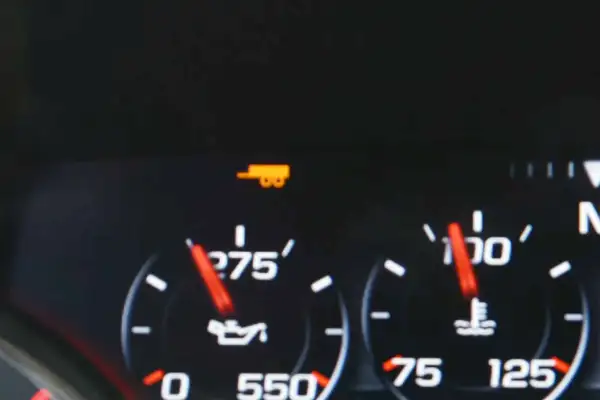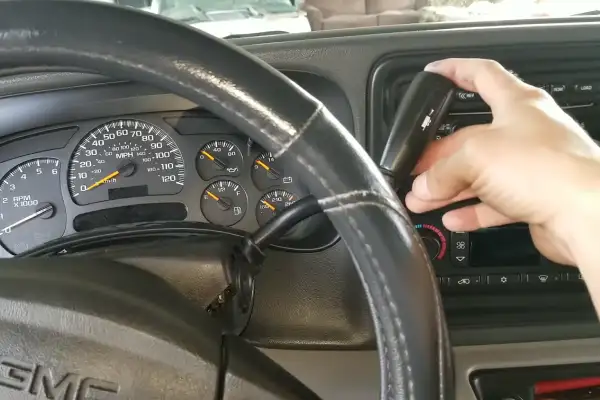Regarding towing, one of the essential indicators you’ll encounter on your vehicle’s dashboard is the tow/haul light. The tow/haul light is more than just a mere illumination; it carries crucial indications regarding the performance of your vehicle.
It serves as a signal that the tow/haul mode has been activated. Upon pressing the tow/haul button, this light will illuminate. The tow/haul light can also serve as a warning signal.
If it flashes for approximately three seconds before turning off, it’s attempting to alert you to a potential issue within your vehicle’s system or components.
We will discuss in detail when the tow/haul light comes on so that you can better understand its significance.
Under What Circumstances Does the Tow/Haul Light Come On?

There are several circumstances that can lead to the activation of the Tow/Haul light on your vehicle’s dashboard. Below are the key scenarios in which you might encounter this indicator:
- Activation of tow/Haul mode
- Transmission malfunction
- Low transmission fluid level
- Transmission overheating
- Defective solenoid
- Electric circuit issues
- Extended periods of parking
- Gear changes
Now examine each circumstance in-depth, so you can determine when tow haul light activation is normal and when not.
1. Activation of Tow/Haul Mode
When you intentionally press the tow/haul button in your vehicle, it triggers the tow/haul mode to activate.
The tow/haul mode adjusts the transmission shift patterns for better towing or hauling performance when double towing, causing the tow/haul light to illuminate on your dashboard.
2. Transmission Malfunction
The tow/haul light can turn on as a diagnostic indicator for possible transmission trouble.
If the transmission system perceives a malfunction, such as an abnormal change in gear or an upshift issue, it may activate the tow/haul mode to prevent severe damage.
When this happens, the tow/haul light gives you a warning to address the underlying problem as soon as possible.
3. Low Transmission Fluid Level
A low or depleted transmission fluid level is another culprit that can activate the tow/haul light. This light serves as a gentle reminder to check the fluid level and fill it up if needed.
When the transmission fluid is low, the transmission may operate inadequately and activate the tow/haul mode to reduce the risk of further damage.
4. Transmission Overheating
Another circumstance that triggers the tow/haul light is the overheating of the transmission. This situation usually results from prolonged driving trips without stopping or if the engine temperature rises significantly.
When the transmission reaches a critical temperature threshold, the vehicle automatically engages in the tow/haul mode to minimize stress on the transmission’s vital components.
The tow/haul light serves as an essential warning to alert you of the transmission overheating issue before it’s too late.
So, if you see the tow/haul light due to overheating, it’s essential to pull over and allow the transmission to cool down before continuing your journey.
5. Defective Solenoid
A faulty solenoid can also trigger the tow/haul light. The solenoid plays a critical role in the ignition system and can impact the vehicle’s ability to start.
If your vehicle has a defective solenoid, you may experience difficulty starting your vehicle. This issue eventually leads to the tow/haul light turning on as an indicator of the problem.
When the solenoid is faulty, it can also cause other engine-related issues such as stalling, poor acceleration, and other malfunctions. These problems arise due to the solenoid’s failure to send the appropriate signals to the engine components.
Therefore, if you notice the tow/haul light is on because of a defective solenoid, you should have your vehicle inspected by a qualified mechanic. They will identify the issue and replace the solenoid as necessary to eliminate the problem.
6. Electric Circuit Issues
If there are any problems with the electric circuits, it can cause the tow/haul light to come on. The electrical faults may be due to wiring problems, damaged insulation, or other internal damages.
When the transmission control module detects these issues, it will engage the tow/haul mode to prevent further damage to the system.
The warning light is a signal that there is an underlying problem with the electrical circuit, and it is crucial to take your car for a diagnostic test immediately.
7. Extended Periods of Parking
When you leave your vehicle parked for an extended period, you may notice the tow/haul light briefly flash when you start the engine.
This should not cause any concern as it’s a normal occurrence when your vehicle has been stationary for a while.
The light will come on with several other dashboard lights during startup as part of the self-test system.
Furthermore, the transmission is functioning correctly if you experience this flashing when you start the engine.
8. Gear Changes
The tow/haul light is closely associated with the gear-shifting process of your vehicle.
Every time you shift gears, such as moving from park to drive or shifting into Reverse, the tow/haul light may briefly flash. This is a normal part of the gear-shifting process and is nothing to be concerned about.
Can an aftermarket towing accessory installation impact the tow/haul light’s functionality?

Installing aftermarket towing accessories incorrectly can potentially affect the functionality of your vehicle’s tow/haul light.
When these accessories are installed improperly, they can disrupt the electrical and transmission systems that are closely linked to the tow/haul mode.
This can trigger the tow/haul light or cause other issues. To avoid complications, it’s crucial to have aftermarket towing accessories professionally installed.
A reputable commercial towing service always uses tow/haul mode with update accessories for heavy-duty towing.
Is it safe to continue driving when the tow/haul Light is flashing?
Ignoring the flashing tow/haul light and continuing to drive could potentially lead to further damage and costly repairs. When this light is illuminated, it indicates an issue with your vehicle’s transmission system or other critical components.
Driving with a flashing tow/haul light may compromise the safety of your vehicle, especially if the transmission isn’t functioning properly.
To prevent further damage and ensure your safety, it’s crucial to pull over, turn off your vehicle, and seek assistance from a qualified mechanic to address the issue promptly.
Do all vehicles have a tow/haul mode light?
Not all vehicles are equipped with a tow/haul mode light. This feature is typically found in vehicles with automatic transmissions, like SUVs and trucks. Manual transmission vehicles don’t have a tow/haul button and light, as it’s specific to automatic transmissions.
When you hire a commercial truck towing service near me, you will notice that they have modern vehicles equipped with tow/haul mode. As a result, they tow safely without causing damage to your car.
It’s a feature designed to optimize the vehicle’s capabilities when towing heavy objects or navigating challenging terrain.
The Tow/Haul Light as Your Guide for Safe Towing
The tow/haul light in your vehicle serves as both a helpful tool and a warning signal, providing valuable insights into your vehicle’s performance.
When it illuminates, it indicates the activation of the tow/haul mode, which optimizes your vehicle for towing or hauling heavy loads.
However, if it flashes, it’s alerting you to potential issues, including transmission problems, low fluid levels, or overheating.
Understanding these circumstances is vital for safe and efficient towing experiences. Always address a flashing tow/haul light promptly to avoid further damage and to preserve your vehicle’s longevity.
So, the next time you see that tow/haul light, pay attention and take appropriate action to keep your vehicle running smoothly. By familiarizing yourself with the tow/haul light, you can enjoy a more pleasurable towing journey.
